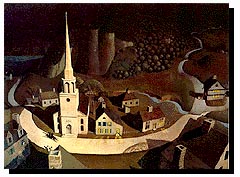

United States History, 17A
The Midnight Ride of Paul Revere
In April of 1775, Paul Revere was 40 years old.
He was an engraver (see his 'Boston Massacre'), a silversmith, a surgeon,
a dentist and a patriot. He was a member of a 'vigilance committee' formed
in Boston a few months earlier. Its purpose was to watch the movements
of the British troops quartered there. The committee was especially interested
in protecting its storehouse of war supplies that it was gathering in the
town of Concord, about 20 miles northwest of Boston. The committee knew
that the troops would soon move on Concord, but they did not know exactly
when.
On Sunday, April 16, 1775, Paul Revere was sent
out to Lexington -- about halfway between Boston and Concord -- to warn
two fugitives who were hiding there. They were John Hancock and Samuel
Adams, wanted by British authorities for their roles in the Boston Tea
Party. Revere warned them that they should be ready to move quickly if
the British troops decided to advance on Concord. When he returned to Boston,
Revere arranged a signal to warn the people across the Charles River in
Charlestown when and how the troops were leaving the city. He would have
one latern placed in the belfry tower of the Old North Church if the British
were leaving the city by land. Two lanterns would mean they were leaving
by sea -- that is, across the Charles.
Tuesday, April 18, 1775, was clear and cold.
A day-long rain ended by late afternoon as the British troops began to
move out of Boston for Concord across the Charles River. Revere instructed
a friend to place two lanterns in the Old North Church. He then rowed across
the Charles where he got a horse and headed northwest toward Lexington.
That was about 11:00 p.m. As he recalled later, he shouted a warning that
the regulars were "coming out" at "almost every house". At about midnight
he arrived at Clark's Tavern. A half-hour later, another rider arrived
at Clark's. He was William Dawes, also a member of the vigilance committee
who had ridden out a different way just in case Revere had been captured.
Shortly before 1:00 a.m. on the morning of the
19th of April, Revere and Dawes rode off toward Concord. Along the way
they met a Dr. Samuel Prescott of Concord who was riding home after visiting
a girlfriend in Lexington. Since they were all headed in the same direction,
they decided to ride together. The following is from his narrative of the
events of that night, written by Paul Revere himself:
"When we had got about halfway from Lexington
to Concord, the other two riders stopped at a house to awaken a man. I
kept along. When I had got about 200 yards ahead of them, I saw two British
officers under a tree. I immediately called for Dawes and Prescott to come
up. But in that instant I saw 4 officers, who rode up to me with their
pistols in their hands and said, 'Goddamn you, stop! If you go an inch
further, you are a dead man.
"Immediately Dr. Prescott came up and we attempted
to get through them, but they kept before us and swore if we did not turn
into a nearby pasture, they would blow our brains out. Dr. Prescott said
to me, 'Put on'. He took to the left. I turned to the right towards a wood,
intending when I had gained that to jump my horse and run afoot. But just
as I reached it, out came 6 officers, who seized my bridle, put their pistols
to my breast, and ordered me to dismount, which I did."
Prescott and Dawes got away, but Revere was
captured by this British patrol. They detained him for about a half-hour,
asking him questions about why he was out riding that night. They 'abused
me verbally', Revere said, and 'called me a damned rebel'. Finally they
took his horse and let him go. Revere returned to Clark's Tavern where
he spent that night, never actually completing the 'midnight ride' all
the way to Concord.
Please answer the following questions:
17. What did Paul Revere shout to warn the countryside, and
who was the other patriotic rider not mentioned in Longfellow's poem?
18. Compare this narrative of the actual events of the night
of April 18/19, 1775, with those in the poem, "The
Midnight Ride of Paul Revere", by Longfellow. How far did William Dawes
ride in each version?
19. The painting, above, is by Grant Wood and shows Paul
Revere on his way from Lexington to Concord. Compared to the real
events of that night, what is wrong with this painting?

 Return
to Study Guide #4
Return
to Study Guide #4
 Revised
June 3, 2002
Revised
June 3, 2002
by Tom Gallup, e-mail address: [email protected]
West Valley College
http://www.westvalley.edu/wvc/ss/gallup/gallup.html



![]() Revised
June 3, 2002
Revised
June 3, 2002